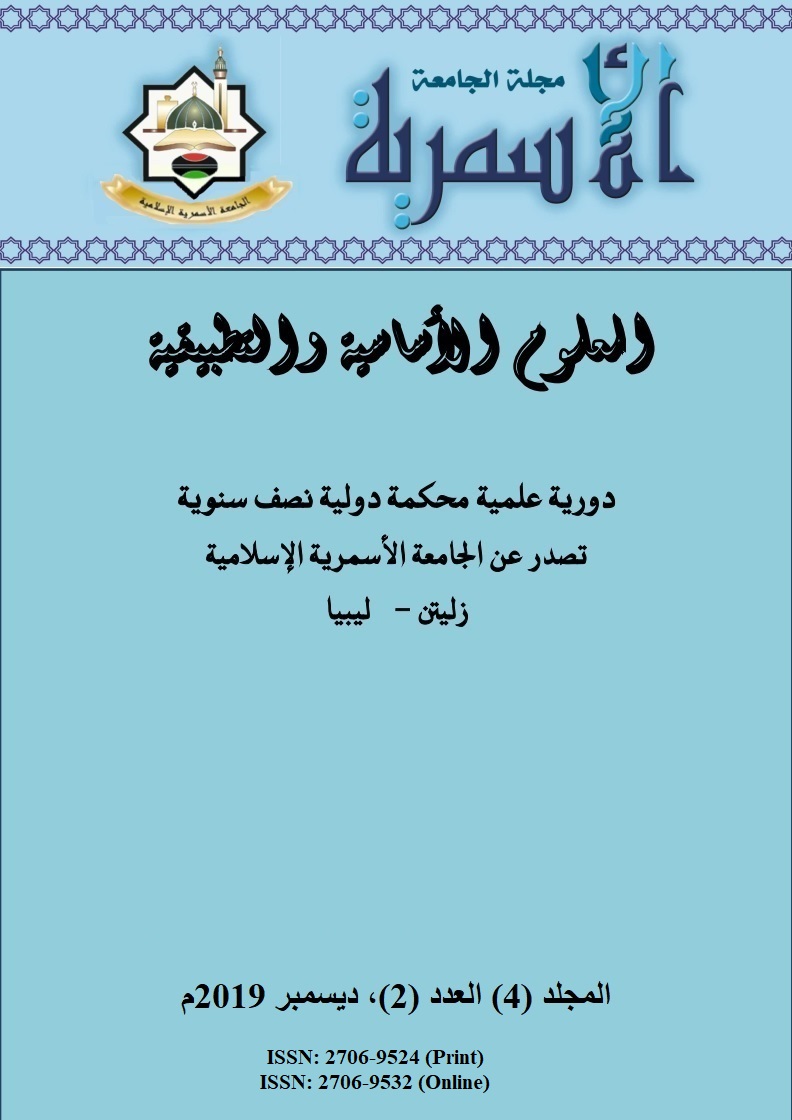Investigation of the Genus Anisakis Among Atlantic Chub Mackerels (Scomber colias Gmelin, 1789) in Tripoli's Main Fish Markets, Libya
DOI:
https://doi.org/10.59743/aujas.v4i2.1600الكلمات المفتاحية:
Anisakis simplex، Atlantic chub mackerel، consumer، public health، Anisakidosis، Tripoli، Libyaالملخص
Parasitism is a common incident in the marine environment and all species of fish are susceptible to being infested by various parasites. Thousands of parasitic species of fish are described in adult or larval form, which mainly belong to the groups of protozoa, arthropods, plathihelminths (trematodes and cestodes) and nematohelminths (nematodes). Anisakidosis is a zoonosis caused by the intake of the nematode of the genus Anisakis in its third larval stage (L3). Atlantic chub mackerel (Scomber colias Gmelin, 1789), has great importance, both ecologically and economically in the Libya. From the economic point of view, it is possible to mean that Atlantic chub mackerel is the one of most abundant and frequent medium-sized pelagic species of fishing in the Libyan coastline. Atlantic chub mackerel is one of the most commercial significant species for the Libyan fishery. Consequently, in the period between 1st March to 28th April 2018, a total of 83 Atlantic chub mackerels were collected from two main fish markets in Tripoli, Libya to evaluate the parasitosis by infective larvae of the genus Anisakis spp. by the dissection method. Among the all examined fish, 15 (18.07%) were infested in the abdominal cavity with nematodes parasites, and identified as a third stage larvae, belonging to the Anisakis simples. Statistical analysis revealed there is no correlation between abundance of the infection by A. simplex with the host length. Furthermore, values of the infection intensity were significantly higher in the female of S. colias. However, this study indicates the need to continue efforts for in-depth investigate this metazoan parasite in different fish and cephalopod species in the coast of Tripoli, to represent the adequate risk of anisakidosis, and to alert the possible chance of the initial man case of anisakidosis in Libya, particularly among people who are more occupationally susceptible; like the fishmongers, fish processors, as well as to some residents population who prefer consume the raw or lightly cooked fish.
التنزيلات
المراجع
Asato, R.; Wakuda, M; and Sueyoshi. T. (1991). A case of human infection with Anisakis physeteris larvae in Okinawa, Japan. Jpn. J. Parasitol., 40:181-183.
Audicana, M. T; and Kennedy; M. W. (2008). Anisakis simplex: from obscure infectious worm to inducer of immune hypersensitivity. Clin. Microbiol. Rev., 21, pp. 360-379. DOI: https://doi.org/10.1128/CMR.00012-07
Chen, Q; Yu, H. Q; Lun, Z. R; Chen, X. G; Song, H. Q; Lin, R. Q., Zhu X Q. (2008). Specific PCR assays for the identification of common anisakid nematodes with zoonotic potential, Parasitol Res., 104(1): 79-84. DOI: https://doi.org/10.1007/s00436-008-1161-7
Cheng, T. (1986). General Parasitology. 2nd ed. Orlando. Academic Press, pp. 523- 528.
Collette, B. B; and C. Nauen (1983). Scombrids of the world. An annotated and illustrated catalogue of tunas, mackerels, bonitos and related species known to date. FAO Species Catalogue. FAO Fisheries Synopsis 125(2). pp. 137.
Collette, B. B. (1986). Scombridae. In: Fishes of the Northeastern Atlantic and the Mediterranean. Volume II. UNESCO, Paris. By; Whitehead, P.J. P., M.L. Bauchot, J. C. Hureau, J. Nielsen and E. Tortonese (Eds), pp. 981-997. DOI: https://doi.org/10.2307/1444931
Daschner, A; Alonso-Gómez, A; Cabañas, R; Suarez-de-Parga, J M; López-Serrano M C. (2000). Gastroallergic anisakiasis: borderline between food allergy and parasitic disease-clinical and allergologic evaluation of 20 patients with confirmed acute parasitism by Anisakis simplex. J. Allergy Clin. Immunol., 105:176-181. DOI: https://doi.org/10.1016/S0091-6749(00)90194-5
Ishikura, H; K. Kikuchi; K. Nagasawa; T. Ooiwa; H. Takamiya; N. Sato and K. Sugane. (1992). Anisakidae and anisakidosis. In: T. Sun. (Ed). Prog. Clin. Parasitol., Springer-Verlag, New York, pp. 43-102. DOI: https://doi.org/10.1007/978-1-4612-2732-8_3
Kagei, N; M. Sano; Y. Takahashi; Y. Tamura; Sakamoto, M. (1978). A case of acute abdominal syndrome caused by Anisakis type-II larva. Jpn. J. Parasitol., 27:427-431.
Kardousha, M. M. (1992). Helminth parasite larvae collected from Arabian gulf fish (coasts of the United Arab Amirates) (I) Anisakid larvae (Nematoda: Anisakidae). Jpn. J. Parasitol., 41:464-472.
Kassai, T; Cordero Del Campillo, M; Euzeby, J; Gaafar, S; Hiepe, T; Himonas, C. A. (1988). Standardized nomenclature of animal parasitic diseases (SNOAPAD). Vet. Parasitol., 29, 299-326. DOI: https://doi.org/10.1016/0304-4017(88)90148-3
Margolis, L; Esch, G. W; Holmes, J. C; Kuris, A. M; Schad, G. A (1982). The use of ecological terms in parasitology (report of an ad hoc committee of the American Society of Parasitologists). J. Parasitol., 68: 131-133. DOI: https://doi.org/10.2307/3281335
Mattiucci, S; Nascetti, G; Cianchi, R; Paggi, L; Arduino, P; Margolis, L; Brattey, J; Webb, S. C; D' Amelio, S; Orecchia, P; Bullini, L. (1997). Genetic and ecological data on the Anisakis simplex complex with evidence for a new species (Nematoda, Ascaridoidea, Anisakidae). J. Parasitol., 83, 401-416. DOI: https://doi.org/10.2307/3284402
Mattiucci, S; Nascetti, G; Dailey, M; Webb, S. C; Barros, N; Cianchi, R; Bullini, L. (2005). Evidence for a new species of Anisakis Dujardin, 1845: morphological description and genetic relationships between congeners (Nematoda: Anisakidae). Sys. Parasitol., 61: 157-171. DOI: https://doi.org/10.1007/s11230-005-3158-2
Mattiucci, S; Paggi, L., Nascetti, G; Portes Santos, C; Costa, G; Di Beneditto, A. P; Ramos, R; Argyrou, M; Cianchi, R; Bullini, L. (2002). Genetic markers in the study of Anisakis typical (Diesing, 1860): larval identification and genetic relationships with other species of Anisakis Dujardin, 1845 (Nematoda: Anisakidae). Sys. Parasitol., 51, 159-170. DOI: https://doi.org/10.1023/A:1014554900808
Paggi, L; Mattiucci, S; Gibson, D. I; Berland, B; Nascetti, G; Cianchi, R; Bullini, L. (2000). Pseudoterranova decipiens species A and B (Nematoda, Ascaridoidea): Nomenclatural designation, morphological diagnostic characters and genetic markers. Sys. Parasitol., 45: 185-197. DOI: https://doi.org/10.1023/A:1006296316222
Siegel, S.; and Castellan, N. J., Jr. (1988). Nonparametric statistics for the behavioral sciences (2nd ed.). McGraw-Hill Book Company New York.
Strømnes, E; and K. Andersen. (2000). “Spring rise” of whaleworm (Anisakis simplex; Nematoda, Ascaridoidea) third-stage larvae in some fish species from Norwegian waters. Parasitol. Res., 86:619-624. DOI: https://doi.org/10.1007/PL00008541
Vidaček, S; de las Heras, C; Solas, M.T; Mendizábal, A; Rodriguez-Mahillo, A.I; González-Muñoz, M; Tejada, M. (2009). Anisakis simplex allergens remain active after conventional or microwave heating and pepsin treatments of chilled and frozen L3 larvae J. Sci. Food Agric., 89, pp. 1997-2002. DOI: https://doi.org/10.1002/jsfa.3677
Zar, J. H. (1996). Biostatistical Analysis. 3rd Edition, Prentice-Hall, Upper Saddle River, pp. 662.
منشور
إصدار
القسم
الرخصة
الحقوق الفكرية (c) 2019 مجلة الجامعة الأسمرية

هذا العمل مرخص بموجب Creative Commons Attribution 4.0 International License.
تتعلق الحقوق بنشر وتوزيع البحوث المنشورة في مجلة الجامعة الأسمرية، حيث توضح للمؤلفين الذين نشروا مقالاتهم في مجلة الجامعة الأسمرية، كيفية استخدام أو توزيع مقالاتهم، والاحتفاظ بجميع حقوقهم في المصنفات المنشورة، مثل (على سبيل المثال لا الحصر) الحقوق التالية:
- حقوق الطبع والنشر وحقوق الملكية الأخرى المتعلقة بالمقال المقدم، مثل حقوق براءات الاختراع.
- استخدام البحث المنشور في مجلة الجامعة الأسمرية في الأعمال المستقبلية الخاصة بالمؤلفين، بما في ذلك المحاضرات والكتب، والحق في إعادة إنتاج المقالات لأغراضهم الخاصة، والحق في الأرشفة الذاتية لمقالاتهم.
- الحق في الدخول في مقال منفصل، أو للتوزيع غير الحصري لمقالاتهم مع الإقرار بنشره الأولي في مجلة الجامعة الأسمرية.
الحقوق الفكرية: وفق الرخصة الدولية للأعمال الإبداعية المشاعة، النسخة 4.0.
بيان الخصوصية: سيتم استخدام الأسماء وعناوين البريد الإلكتروني التي تم إدخالها في موقع مجلة الجامعة الأسمرية للأغراض المذكورة فقط والتي استخدمت من أجلها.











